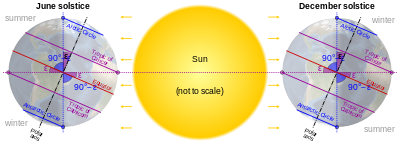Polar circle



A polar circle is either the Arctic Circle or the Antarctic Circle. On Earth, the Arctic Circle is located at a latitude of 66°33′50.1″ N, and the Antarctic Circle is located at a latitude of 66°33′50.1″ S.[1]
Areas inside each polar circle and its associated pole (North Pole or South Pole), known geographically as the frigid zones, would theoretically experience at least one 24-hour period when the sun is continuously above the horizon and at least one 24-hour period when the sun is continuously below the horizon annually. However, due to atmospheric refraction and the Sun being an extended object rather than a point source, the continuous daylight area is somewhat extended while the continuous darkness area is somewhat reduced.
The latitude of the polar circles is 90 degrees minus the axial tilt of the Earth's axis of daily rotation relative to the ecliptic, the plane of the Earth's orbit. This tilt varies slightly, a phenomenon described as nutation. Therefore, the latitudes noted above are calculated by averaging values of tilt observed over many years. The axial tilt also exhibits long-term variations as described in the reference article (a difference of 1 second of arc in the tilt is equivalent to change of about 31 metres north or south in the positions of the polar circles on the Earth's surface).

| The north polar circle on a polar projection. |

|
| The polar circle as lines on an modified cylindrical projection. |
See also
- Arctic Circle
- Antarctic Circle
- Polar region
- Arctic
- Antarctica
- Frigid Zones
- Polar climate
- Polar day & Polar night

